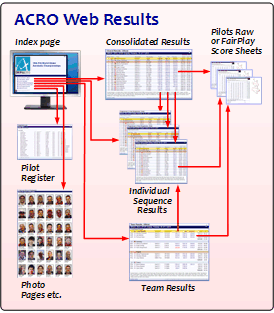|
|
||||||||||||||||||
| An Overview of the ACRO Web Results production system | ||||||||||||||||||
| Without going outside the ACRO software environment you can create comprehensive web output from your results and other data, and upload it all with an Index to a web folder of your choice. When the FairPlay System is used individual Judge Analysis pages will be linked to the judge's names at the foot of each single sequence results page. | ||||||||||||||||||
| If you are working at a CIVA event, to upload the championship results to the CIVA Results website you must use ACRO's inbuilt ftp client to post all the results as this website is secured against access by any other method - an alternative ftp client will not work. | ||||||||||||||||||
| ● |
Create individual or combined sequence results in web format via the Web Contest Results form. |
 |
||||||||||||||||
| ● | Create individual or combined sequence team results in web format via Web Team Results | |||||||||||||||||
| ● | Create any number of other web pages using ACRO, local or external editing facilities | |||||||||||||||||
| ● | Upload these files to a remote server folder, to a local folder in your computer or to a remote folder on a network using Web Files Upload Manager. Alternatively an external FTP client or a server based file uploader can be used to transfer the files as required, but this solution is risky and to be avoided if possible. | |||||||||||||||||
|
You can use ACRO in conjunction with any other resources to create the files you need. |
||||||||||||||||||
|
You can then upload all of these files to the contest website or to a network target folder for local browser access. |
||||||||||||||||||
| You can create and upload "web-ready" output in these eight areas: | ||||||||||||||||||
|
||||||||||||||||||
|
Server
folder and files structures It is important to understand that the ACRO web system expects ALL of these files - HTML, graphics, style-sheets etc. - to all be held in a SINGLE destination folder. Filenames must therefore all be unique, duplications are not possible. ACRO will ensure that all the 'internally' created files have unique filenames - YOU must take the same care when including external pages etc.. |
||||||||||||||||||
| Note that if you use an external WYSIWYG editor (ie. Dreamweaver, FrontPage, Word etc.) to produce files for access via the web index page, they may generate sub-folders for images or other graphic elements, and you must take steps to ensure that this is avoided or that sub-folder files are all successfully re-located to and linked within ACRO's single flat folder arrangement. | ||||||||||||||||||
|
||||||||||||||||||